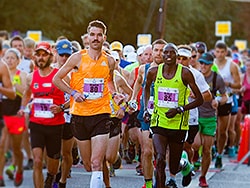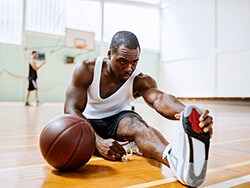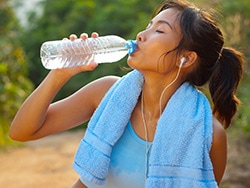Could Philippides Have Been Saved?
According to legend, the messenger died after running 40 kilometers to announce news of the Battle of Marathon in 490 BC. What if he had followed current health recommendations and transitioned gradually to a slower and slower pace before stopping?

The question isn't just historical; around the world, athletes still continue to die shortly after exertion. In February, the Standard Chartered Hong Kong Marathon added a third runner to its list of those who have died after crossing the finish line in its various events over the past 5 years, according to the South China Morning Post.[1]
Stress on the heart could explain a lot of the deaths that occur during exercise. But why should there be more deaths afterward? The question doesn't only apply to athletes. People whose work requires vigorous physical activity could also be affected by questions of body temperature, points out Juha Oksa, PhD, a senior research scientist and the Finnish Institute of Occupational Health in Oulu, Finland.
Warming Up Before Vigorous Activity
The American College of Sports Medicine (ACSM)[2] and the American Heart Association[3] both recommend a warm-up phase before vigorous activity and a cooldown afterward.
Warming up serves a variety of purposes, says Dr Oksa. To start with, it increases the rate at which adenosine triphosphate can break down, so more energy is available, he explains. Nerve conduction and muscle contraction velocity increase. Muscles and tendons become more elastic and therefore less likely to tear.
Warm-up routines aim to increase core temperature by about 1°C, from about 37°C to about 38°C, says Dr Oksa.
Much warmer, though, and the opposite problem can occur. "There is a fatigue hypothesis that if your body hits a certain level, it tries to stop the activity from happening," says Mark Russell, PhD, associate professor in performance nutrition and applied exercise physiology at Leeds Trinity University in Leeds, United Kingdom. People who fight through that fatigue may reach hyperthermia, a condition in which such processes as cellular respiration no longer function properly, and heat stroke can ensue.
So how can people tell when they have warmed themselves up to 1°C but no more? Researchers such as Dr Russell use thermometers that can be swallowed and read with wireless devices, he says. But he's never heard of athletes attempting something quite that technological for a sporting event.
Dr Oksa says you'll know you're ready when you feel "light sweating and ventilation is increased; you are warm all over your body; and you don't feel tense in your muscles."
The ACSM recommends "5 or 10 minutes of low intensity large-muscle activity that progresses to an intensity at the lower end of the target exercise range."[2] Dr Russell, who works with professional sports teams, thinks 20 minutes to a half-hour is more reasonable for these athletes. That amount of time allows players to practice the skills they will be using in a game.

In hot or humid conditions, he recommends shortening the duration of the warm-up to avoid hyperthermia, but not decreasing its intensity, which should still resemble the exercise for which the athletes are preparing.
To properly prepare without overheating in hot weather, some teams now use external means of cooling athletes before exercise. For example, the athletes might drape themselves with ice-wrapped in towels. "If you cool an individual's core temperature before they exercise, they have a bigger capacity to absorb heat," Dr Russell says.
But some conditions might call for the opposite. Dr Russell and his colleagues have been researching methods of keeping athletes from cooling down between the end of the warm-up and the start of a match, or during breaks.
In one study, they compared the performance of 15 rugby players who performed a warm-up consisting of jogging, skipping, bounding, dynamic stretches, plyometric strides, sprinting, and jumping. During this time, the players' core temperatures steadily increased by almost 1°C. The rugby players then divided into four groups that tried different techniques for maintaining that temperature for 20 minutes.[4] After that, they all underwent tests of sprinting speed and jumping power.
For 20 minutes after the warm-up, one group wore standard training attire while remaining at rest. This group lost 85% of the temperature increase it had gained during the warm-up. Compared with the other groups, this group performed the worst on both sprinting and jumping.
A second group wore long blizzard survival jackets while remaining at rest. This group lost only about 30% of its core temperature gain, and came in second in sprinting and third in jumping.
A third group, wearing normal training clothes, waited at rest for 12 minutes, then jumped up and down 15 times. This group experienced temperature losses similar to the first group. It performed about the same as that group in sprinting but was second best in jumping.
A fourth group followed the same procedure as the third group, but wore blizzard survival jackets except while jumping. Similar to the second group, this group lost about 30% of the core body temperature it gained during warm-up. And it performed the best in sprinting and jumping.
The trial showed that bundling up to stay warm and staying active during breaks both make a big difference, the researchers concluded.
Cooling Down Gradually After Exertion
So if warming up is so beneficial, why bother cooling down after sports? An ACSM guide for personal trainers recommends about 10 minutes of gradually decreasing movement after an exertion, or 5 minutes if the only exertion was brisk walking. "By allowing a gradual progression toward resting rather than abruptly stopping exercise, the client will avoid an acute, excessive drop in blood pressure that could result in dizziness," the guide says.[2]

In addition, the pump-action of large muscles keep blood flowing to clear out waste products from the exertion, says Dr Oksa. "In a way, you are washing out the metabolic by-products in the muscle."
Researchers have also theorized that gradual cessation of exercise could prevent blood pooling in extremities, and might change blood chemistry in ways that prevent dangerous clotting.[5]
There are few studies to show that this approach has actual health benefits. "It's primarily theoretical," says Dr Russell. "There really isn't a lot of relevant research."
But there is some. Studies have shown the prevalence of ischemic events is higher during and after heavy exercise, and that a gradual cooldown significantly enhances clearance of plasma catecholamines associated with activation of coagulation factors and platelet binding.[5]
For example, in a 2004 study, researchers at Michigan State University in East Lansing found that 10 persons who cooled down gradually by walking after running had lower levels of von Willebrand factor antigen for 1 hour after the running. Von Willebrand factor is a blood glycoprotein that is important in platelet adhesion.[5]
Such findings have led organizers of some marathons to provide "hot walkers," volunteers who coach runners to keep moving for a while after crossing the finish line.
If his compatriots had provided such coaching to Philippides, imagine the messages he might have lived to deliver.
Medscape Orthopedics © 2017 WebMD, LLC
Any views expressed above are the author's own and do not necessarily reflect the views of WebMD or Medscape.
Cite this: Researchers Probe the Art of Athletic Warm-up and Cooldown - Medscape - Mar 29, 2017.











Comments